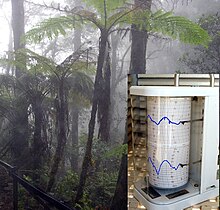Heat index
| Humidity and hygrometry | |
|---|---|
 |
|
| Specific concepts | |
| General concepts | |
| Measures and Instruments | |
The heat index (HI) or humiture or humidex (not to be confused with the Canadian humidex) is an index that combines air temperature and relative humidity, in shaded areas, as an attempt to determine the human-perceived equivalent temperature, as how hot it would feel if the humidity were some other value in the shade. The result is also known as the "felt air temperature" or "apparent temperature". For example, when the temperature is 32 °C (90 °F) with 70% relative humidity, the heat index is 41 °C (106 °F). This heat index temperature has an implied (unstated) humidity of 20%. This is the value of relative humidity for which the heat index formula indicates 41 °C feels like 41 °C. A heat index temperature of 32 °C has an implied relative humidity of 38%.
The human body normally cools itself by perspiration, or sweating. Heat is removed from the body by evaporation of that sweat. However, high relative humidity reduces the evaporation rate. This results in a lower rate of heat removal from the body, hence the sensation of being overheated. This effect is subjective, with different individuals perceiving heat differently for various reasons (such as obesity, metabolic differences, pregnancy, menopause, effects of drugs and/or drug withdrawal); its measurement has been based on subjective descriptions of how hot subjects feel for a given temperature and humidity. This results in a heat index that relates one combination of temperature and humidity to another.
Because the humidity index is based on temperatures in the shade, while people often move across sunny areas, then the heat index can give a much lower temperature than actual conditions of typical outdoor activities. Also, for people exercising or active, at the time, then the heat index could give a temperature lower than the felt conditions. For example, with a temperature in the shade of only 82 °F (28 °C) at 60% relative humidity, then the heat index would seem 84 °F (29 °C), but movement across sunny areas of 102 °F (39 °C), would give a heat index of over 137 °F (58 °C), as more indicative of the oppressive and sweltering heat. Plus when actively working, or not wearing a hat in sunny areas, then the feels-like conditions would seem even hotter. Hence, the heat index could seem unrealistically low, unless resting inactive (idle) in heavily shaded areas.
...
Wikipedia
